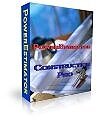
Comprehensive Software Suite for Construction Cost Estimating
PowerEstimator Construction Pro
The best way to create office productivity is now the easiest way to build accurate construction cost estimates. You can now work in a single MS Excel environment to quickly create, build and manage your estimates.
Construction Pro is a PowerEstimator productivity suite of essential MS Excel spreadsheet template based cost estimator and job cost software. Construction Pro is a complete suite of construction trade-specific software titles including:
General Contractor for Excel
Remodel Contractor for Excel
Paint Contractor for Excel
Home Builder for Excel
Roof Contractor for Excel
JobCost Controller for Excel
Order PowerEstimator Construction Pro below for immediate online download.
Multiple license discounts and an option to also receive CD-ROM available at checkout.
PowerEstimator Construction Pro $69.95
PowerEstimator Construction Pro software title is also available at selected Staples, Office Depot and OfficeMax stores.
Key Benefits PowerEstimator Construction Pro Software
MS Excel spreadsheet template based cost estimating
Built-in, customizable cost data
Current and local cost data including labor
Formal bid quotation generated automatically
Suite of six individual programs covering industry specific applications
Comprehensive Help system and Step-by-Step tutorial
System Requirements
Desktop or laptop computer running on Windows 7 thru Windows 11
MS Excel version 2000-23, Office 365 desktop (32-bit or 64-bit MS Office installation)
Compatible printer
"I like the program and use extensively. Especially useful to add additional cost lines items to each catagory and make it custom for my operation." M.M. Contractor
"Started new business. Love your program. Thanks." C.S. Contractor
Editor’s Corner
Five Common-Sense Rules of Successful Cost Estimating
1. A good estimate must start with a complete understanding of scope of work followed by an accurate quantity takeoff. It's all too easy to miss out identifying items of work in the project. This may be due to absolutely mundane reasons such as missing drawings, details or specs. It could be due to a misinterpretation of the scope based on an ambiguous statement or comment. Or, it could be due to a more serious reason such as lack of experience in conceptualizing the work to be performed in the field.
2. Understand your resources and their cost to you – material suppliers, labor force, subcontractors, construction equipment, indirect costs, management.
Easier said than done, this requires a thorough analysis of costs. A cost engineer or asset manager may very well team up with the comptroller, accountant, field superintendent, project manager, purchasing manager even corporate lawyer. Even outside labor consultants may be hired to reach cost data to be incorporated in estimates. Remember, such data is not static, but changing in time and periodic review and update is a must.
3. Evaluate your strength and weakness and establish comparative advantage
This is where the upper echelons of management should participate to an extensive degree. Typically, they have the background experience not just within the company but with other companies and industries vis-à-vis competition. Once the main parameters are established, the middle management in collaboration within departments may detail out the analysis and attach workable numbers. These, in turn, become the ammunition of choice for the estimating department so that they can come up with an estimate that is not only sufficiently low but also profitable for the company.
4. Determine appropriate Overhead and Profit rates
In order to achieve optimal overhead and profit applications, item 3 above has to be completed so that risk factors are established and evaluated. Considering the general description of profit as being the return for taking a risk, it’s essential that it has to be a calculated risk. To arrive at these figures, not only the company cost structure and records must be thoroughly analyzed but also competition must be evaluated. In general, it is not recommended to trim bid figures from overhead and profit since they represent the long term viability of an ongoing business concern.
5. Use sound estimator’s judgment and keep an open mind and ear
When preparing a bid level estimate, care must be taken to identify not only labor and material cost items shown on the plans, but also labor and cost items that may not be reflected on the plans. This is where good estimating and estimator’s judgement to a large degree comes into play. It’s allright to consult a project manager, an engineer, a field superintendent and even a simple workman. A few new ideas here and a few there may mean understanding the project better and trimming estimating costs which may in turn mean a winning and profitable bid as opposed to a disappointing loss.
Happy Estimating!
